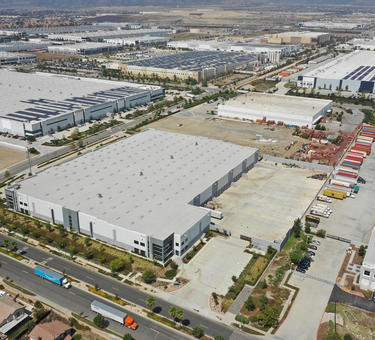Exhibit 1
IBI Activity Index
Q3 IBI Activity Index Deeper Dive:
Recent data suggests imports and retail sales growth are slowing, which would impact the flow of goods through U.S. facilities. Even with these trends, IBI activity showed resiliency by staying above average but has continued to soften moderately. IBI activity decreased 620 bps from the second quarter to 60.2 in October. Logistics users continued to expand their networks and absorbed 90 MSF of space in Q3, which is on par with absorption from the prior quarter. (see Exhibit 1)
Utilization of space increased as inventory build continued. Another driver is the lack of new supply and low vacancy that hinders expansion into new space. The utilization rate held steady at 86% through October, up 40 bps from the second quarter. The functional ceiling for utilization is in the 86-87% range. (see Exhibit 2)
Exhibit 2
Utilization Rate
Exhibit 3
Summary of Net Absorption Indicators
Developers continued to break ground, even with capital markets in flux. Development commitments made earlier in the year and, in some cases, ownership of lower cost-basis land spurred more development. Construction starts reached a record high of 142 MSF in Q3, pushing the construction pipeline to 550 MSF. As the cost of capital continues to rise, development activity may slow in coming quarters. (see Exhibits 4, 5 and 6)
Exhibit 4
Market Fundamentals, U.S. (Net Absorption and Completions)
Exhibit 5
U.S. Vacancy
Exhibit 6
Under Construction, U.S. Industrial
True months of supply (TMOS), the amount of time it would take to absorb all available supply, was low at 21.8 months, up slightly from 18.9 in Q2. A rising TMS for a consecutive quarter may reflect that some markets are on track to become less competitive as leasing options are increasing, signaling an easing of rent growth because the two indicators are highly correlated. TMS will likely continue to grow in lower-barrier locations with large pipelines, such as Dallas, Phoenix and Indianapolis. Markets where TMS will likely remain lower for longer include Inland Empire, Las Vegas, Lehigh Valley and New York/New Jersey. (see Exhibits 7 and 8)
Exhibit 7
U.S. TMS
Exhibit 8
U.S. Rent Growth
Market conditions are expected to remain tight through the rest of the year. Our forecast calls for 370 MSF of net absorption, outpaced slightly by deliveries at 385 MSF. The vacancy rate is expected to remain tight at 3.3%. Even if TMS climbs further, it should not eclipse the mid-20-month range. Given these expectations and robust year-to-date rent growth, Prologis Research adjusted the full-year 2022 rent growth forecast up 300 bps to 28%.
Looking ahead into 2023, leasing momentum is expected to normalize from the frenzied tempo of recent years. The pace of decision-making has already slowed and is not expected to reaccelerate due to greater economic uncertainty. At the same time, users will have more options as the construction pipeline empties. Compared with 2022, Prologis Research expects more deliveries and slightly lower net absorption, roughly in line with the annual demand run rate at the current level of IBI activity. The vacancy rate is expected to expand. Market rent growth is expected to outpace inflation, and TMS is expected to rise. Taken together, competition may ease in some places, but planning will be pivotal in key locations where options should continue to be limited.



